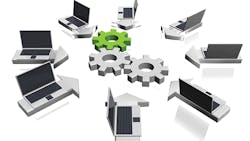Reduce the Risks of Underutilized Machine Assets
A new business model is rapidly evolving to monetize a company's underemployment of its commercial machines. It is referred to as a peer-to-peer commercial machine rental electronic exchange, or P2P/CMR/EE. The structure of this model looks like this:
- The asset owner recognizes that the planned utilization of its machine is above actual demand, resulting in the fixed costs of machine ownership becoming a greater financial burden on the company's cost structure.
- The machine owner decides to mitigate the further risks of the unfavorable fixed cost allocation by monetizing underemployed machine assets.
- The asset owner registers a machine asset with a P2P/CMR/EE with the following: price, availability period, machine specifications and T&C. The machine owner never provides a machine operator, but may provide some other resource, such as consumables.
- The asset owner selects a supplier to manage the asset during its rental period: move asset, if required, maintain the machine, train the operator and others.
- The P2P/CMR/EE connects the buyer of a rental solution with the seller.
- Upon transaction completion, the P2P/CMR/EE obtains their listing fee, the asset manager obtains their fee from the seller and the remainder is retained by the asset owner and applied as a debit to the total ownership cost of the asset. Everyone wins.
Recent examples of a P2P/CMR/EE can be found in the construction/mining machine sector. It is estimated that more than 3 million units in the installed base of construction and mining machines in the U.S. are typically idle more than three-quarters of the available working time. Below are two P2P/CMR/EE currently in existence:
- Yard Club, a San Francisco-based P2P/CMR/EE that has partnered with Caterpillar Rental. The arrangement is that Caterpillar Rental will not only list the rental assets that they own, but will also link assets of Caterpillar machines listed on the Yard Club P2P/CMR/EE.
- Noble Iron, a public company, is the U.S. distributor of Chinese-built LiuGong machines and has created a P2P/CMR/EE for those machines.
In addition to the construction/mining sector, virtually all machine sectors could be candidates for a P2P/CMR/EE: healthcare, on-road transport, aviation, marine, laboratory testing, gas/oil extraction and many others. It is estimated that at least 35% of the commercial machines in the U.S.-installed base could be listed on a P2P/CMR/EE; the replacement asset value [RAV] is an estimated $3 trillion. If annual rental fees could generate 5% of RAV, the annual market would be an estimated $150 billion—not exactly small change, but this projection is for another discussion.
Reduced Safety Stock
Now we come to the heart of our discussion: How does the P2P/CMR/EE impact future demand for product support/aftermarket solutions? Let us count the ways:
- There will be a dampening effect on the acquisition of new machines due to the higher rate of employment per machine. This will result in the lower total investment in initial product support parts packages.
- The number of long-term maintenance contracts will decrease due to lower new machine sales, but could be counterbalanced by current machine owners employing machine manufacturers' long-term contracts to cover their requirements for an asset manager during the rental period.
- The quantity of product support parts, especially shop-level reparable parts, designated as safety stock will decline due to the higher utilization rates of machines, which improves reliability of forecasting accuracy, which is the primary driver of safety stock.
- Modification solutions may increase. Machine owners may want to provide, for marketing purposes, the buyer with the latest-and-greatest configuration of the machine.
- As machine units increase their annual employment, end-of-life will accelerate, driving retirement of machines at an earlier age. Disassembly for parts of these end-of-life units and the supply of their previously-employed parts may become a bigger share of the parts market.
- If machine manufacturers take the lead in a P2P/CMR/EE, they will be able to potentially gather additional operating data as input to their product design, especially dealing with reliability issues.
Improved Productivity
The P2P/CMR/EE business model is very early in its lifecycle stage, but I believe that it is a part of a macro-trend of improving the productivity of the processes in which machines are employed.
Note that productivity is all about reducing the quantity of resources employed per output. Labor is typically the benchmark for productivity improvement, but the cost of a machine employed in a process should also be part of productivity improvement initiatives. There are five ways in which a P2P/CMR/EE will improve the productivity of the process in which a machine owner employs a machine:
- Process units of output can increase, with machine costs per unit of output remaining the same (e.g., a 5% increase in tons excavated, with machine costs increasing 0%).
- Process units of output can increase, with machine costs per unit of output increasing at a slower rate than that of output (e.g., a 5% increase in tons excavated, with machine costs increasing 3%).
- Process units of output can increase, with machine costs per unit of output decreasing (e.g., a 5% increase in tons excavated, with machine costs decreasing 2%).
- Process units of output can remain the same, with machine costs per unit of output decreasing (e.g., a 0% increase in tons excavated, with machine costs decreasing 4%).
- Process units of output can decrease, with machine costs per unit of output decreasing at a faster rate than that of output (e.g., a 2% decrease in tons excavated, with machine costs decreasing 6%).
And ultimately it is always about productivity—the engine that drives our economic system.
Ron http://www.giuntinicompany.comGiuntini is principal of Giuntini & Company Inc., a management consulting, education and research organization, and a member of the MH&L Editorial Advisory Board.
